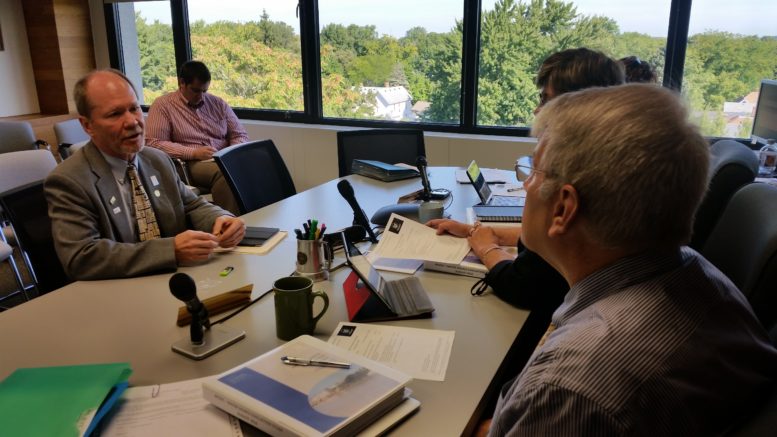By JAN LARSON McLAUGHLIN
BG Independent News
Protecting the health of Lake Erie can be an emotional issue – but the Wood County Commissioners were advised Tuesday to stick to the science.
Bob Midden, a biochemist at BGSU, asked to speak to the commissioners about the health of Lake Erie. He encouraged them to ignore the politics and focus on science when deciding what to do.
“Science can play a very valuable role in addressing these things,” he said. But politics often get in the way, and make decisions suspect.
“What’s more important is to find a way to reduce algal blooms,” Midden said.
In the last month or so, the county commissioners have heard a request from environmentalists that they join other elected officials in the region seeking an “impaired designation” for Lake Erie. And they have heard from a local farmer requesting that they let the agricultural community continue to make improvements rather than adding more regulations.
Midden did not push for either approach, but instead suggested that the commissioners look at strategies that have worked elsewhere. Do voluntary measures work, he asked.
“This is a complex issue,” he said. “But also a very important and very urgent issue. We’ve got a lot at stake.”
At stake are the economics of both the lake and agriculture.
“We don’t want to sacrifice one for the other,” he said.
Also at risk is the health of humans and animals. Midden said ingestion of the algal blooms can cause liver damage, gastrointestinal problems, and death to humans and animals. “It can kill people,” he said. And long-term exposure may cause cancer.
Midden warned that a lack of action will lead to disastrous results.
“We’ve got to get it under control,” he said. “You can consider Lake Erie to be a cesspool eventually if we don’t do anything.”
The commissioners have seen people point fingers at farmers for the problem, and farmers point fingers at overflowing sewer plants. Again, Midden suggested that the commissioners look at science for the answer.
“I’m an evidence guy,” he said.
Midden showed satellite photos of Lake Erie, with consistent evidence that the algal blooms start at the mouth of the Maumee River and in the Sandusky Bay. The Maumee River algal bloom is always the larger one, he said.
Though some people have suspected that Detroit is adding to the problem, the photos showed very little evidence of that where the Detroit River enters the lake.
“You never see a bloom beginning there,” Midden said. “I think that visual is a good indication of what the source is.”
Midden gave credit to the farming community for working to reduce phosphorus and nitrogen running into waterways and eventually Lake Erie. Many farmers are using the “4R” approach of applying the right fertilizer, at the right time, in the right place, in the right amounts.
Not only does keeping the chemicals on farmland help the lake, but it also saves the farmers’ money. As far as manure placement on fields, Midden said if done properly, the recycling of nutrients is a form of sustainable agriculture. But if applied too heavily or before rains, it too ends up in the lake.
“As with anything else, it’s all about how it’s done.”
Some farmers take the steps of soil testing, drainage control and buffer strips – which all help. “I know there are farmers who are using the very best practices.”
But he also knows there are farmers who don’t follow those practices. And because of them, voluntary efforts to curb phosphorus and nitrogen in the lake may not be enough.
“If I was a farmer, I’d prefer voluntary measures,” Midden said. “But I think there are times when regulations make it fairer.”
Commissioner Craig LaHote asked if other factors are contributing to algal blooms since farmers are reporting that they are using less fertilizer. Midden said there could be several factors such as:
- Warming temperatures that aid in the growth of algal blooms.
- Invasive species like zebra mussels, which have cleared the water so more light shines in and aids in the algae growth.
- No-till farming practices, which decrease soil erosion, but also create runoff higher in phosphorus.
“I don’t know that we fully understand all the factors involved,” Midden said.
Midden offered the assistance of BGSU to help the county research the problem and solutions. A communities initiative at BGSU encourages collaboration on such projects.
He referred to the 1960s and 1970s when Lake Erie was in crisis. “The lake was nearly dead,” but requirements were adopted to clean up the water. “We can do that again. We need the will to do what’s needed” and the wisdom to know what that is, Midden said.
Commissioners LaHote and Joel Kuhlman expressed concern about their ability to make an “impaired designation” for Lake Erie. “Who are the commissioners to make this determination,” Kuhlman asked.
Midden suggested the commissioners ask a representative of the EPA to explain who makes the “impaired designation” and what happens as a result. “Clearly this is a big issue. We’ve all got a lot at stake,” he said.

